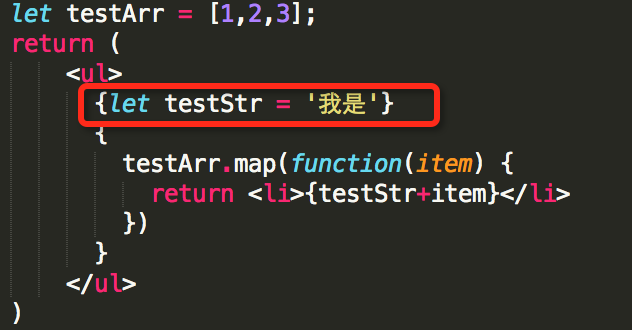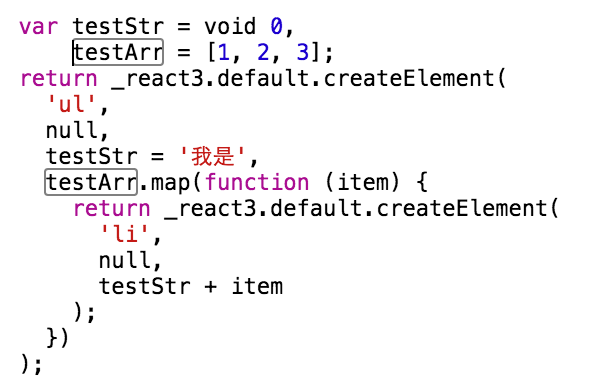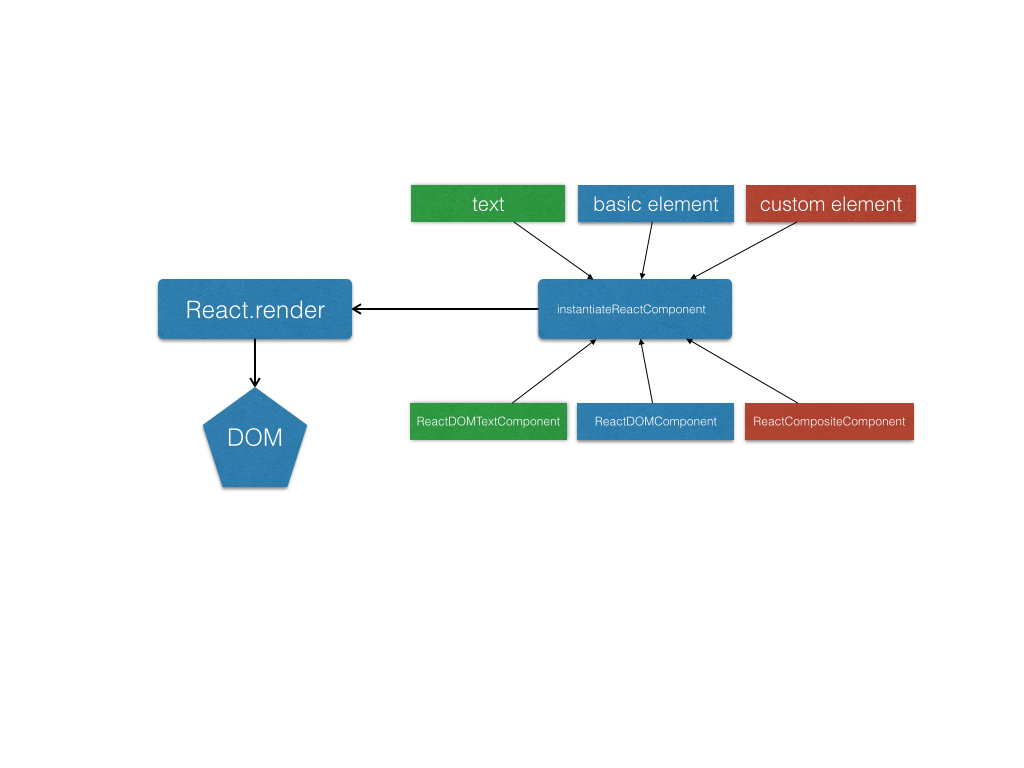新手上路总想在jsx的{}里写正常的js语句,特别是赋值语句。js模板引擎带来的习惯。。。然而jsx不想理你并向你抛来了一堆错误。最近有妹子问我为什么不能用赋值语句,这下还真问倒我了,只知道不能却还真不知道为什么,于是去研究了一番。
jsx是什么?
JSX只是函数调用和对象创建的语法糖。
他跟js模板引擎不一样,不是把{和}看成标识符,标识符内的内容当成js执行。
在jsx中{}内的内容是要被转换成dom标签内的内容的。
jsx会变成什么?
jsx毫无疑问是被转化成js,这些js的功能是创建虚拟dom,最终是要填充到页面上的。
譬如:
return (
<ul>
{
testArr.map(function(item) {
return <li>{item}</li>
})
}
</ul>
)
是要被转成:
_react3.default.createElement(
'ul',
null,
testArr.map(function (item) {
return _react3.default.createElement(
'li',
null,
item
);
})
)
当然不同的编译器转换结果略有差异,不过结构都一样。
jsx如何转换呢?
常使用的方式是通过编译器,譬如babel,babel有专门的插件jsx和babel-preset-react等。现在react太火了,babel自身就集成了编译jsx的功能。
JSX是函数调用和对象创建的语法糖
在编写JSX时,在 { } 中不能使用语句(if语句、for语句等等),但可以使用求值表达式,它是会返回值的表达式。因为他是要被转成createElement的参数的,稍后会讲到,这些参数是明确的值。
jsx里可以有什么
我们不能直接使用语句,但可以把语句包裹在函数求值表达式中运用。
-
立即执行函数,这个方式有点挫。。。
<div> { function(){ let a; //操作a return a; } } </div> -
三目运算符
<div> { a>b?a:b } </div> -
最好的方式是在
render中先处理好需要的值,在return的{}里只包含简单变量或者函数。
抛砖 - {}里合法内容是有返回值的js语句
1)jsx中直接声明赋值会报错:

2) 但是这样却可以:

会被编译成:

最终显示在页面上是:
我是
- 我是1
- 我是2
- 我是3
1)中包含了申明语句,其实是let testStr;testStr='我是',关于let testStrjsx编译器内心是懵逼的,这个语句没有返回值啊!但是直接使用testStr='我是'获取的是testStr的返回值,这个值会被直接打印在页面中。
这就跟你在函数中直接return let testStr='我是'会报错,return testStr='我是'获得的返回值是’我是’一样。jsx会将{}当做返回值处理。所有不能放在 return语句里的内容都会报错。
引玉 - 翻出ReactElement核心源码装波逼
ReactElement.js
/**
* React Element构造器
*/
var ReactElement = function (type, key, ref, self, source, owner, props) {
// 定义element的基本属性
var element = {
// This tag allow us to uniquely identify this as a React Element
$$typeof: REACT_ELEMENT_TYPE,
// Built-in properties that belong on the element
type: type,
key: key,
ref: ref,
props: props,
// Record the component responsible for creating this element.
_owner: owner
};
if (process.env.NODE_ENV !== 'production') {
if (canDefineProperty) {
Object.defineProperty(element._store, 'validated', {
configurable: false,
enumerable: false,
writable: true,
value: false
});
Object.defineProperty(element, '_self', {
configurable: false,
enumerable: false,
writable: false,
value: self
});
Object.defineProperty(element, '_source', {
configurable: false,
enumerable: false,
writable: false,
value: source
});
} else {
element._store.validated = false;
element._self = self;
element._source = source;
}
Object.freeze(element.props);
Object.freeze(element);
}
// 定义了element的完整属性后返回
return element;
};
ReactElement.createElement = function (type, config, children) {
var propName;
var props = {};
var key = null;
var ref = null;
var self = null;
var source = null;
if (config != null) {
ref = config.ref === undefined ? null : config.ref;
key = config.key === undefined ? null : '' + config.key;
self = config.__self === undefined ? null : config.__self;
source = config.__source === undefined ? null : config.__source;
// 将config的内容挂到props下
for (propName in config) {
if (config.hasOwnProperty(propName) && !RESERVED_PROPS.hasOwnProperty(propName)) {
props[propName] = config[propName];
}
}
}
//如果children不知一个,就放到props.children数组里,留给接下来递归渲染
var childrenLength = arguments.length - 2;
if (childrenLength === 1) {
props.children = children;
} else if (childrenLength > 1) {
var childArray = Array(childrenLength);
for (var i = 0; i < childrenLength; i++) {
childArray[i] = arguments[i + 2];
}
props.children = childArray;
}
// Resolve default props
if (type && type.defaultProps) {
var defaultProps = type.defaultProps;
for (propName in defaultProps) {
if (typeof props[propName] === 'undefined') {
props[propName] = defaultProps[propName];
}
}
}
// 创建element
return ReactElement(type, key, ref, self, source, ReactCurrentOwner.current, props);
};
ReactElement.createElement的功能也就是处理一下获取到的type,config,将锁哥children(子组件)平行放入props属性中,并调用ReactElement获取最终的element。
这个element跟浏览器中dom结构不是一个东西,要看他如何发挥作用,还得看render函数如何操作。下面上的都是简化版的代码了。
render函数简化版:
React = {
nextReactRootIndex:0,
render:function(element,container){
var componentInstance = instantiateReactComponent(element);
var markup = componentInstance.mountComponent(React.nextReactRootIndex++);
$(container).html(markup);
//触发完成mount的事件
$(document).trigger('mountReady');
}
instantiateReactComponent.js能够根据不同的类型的node返回相应类型的实例。
//component工厂 用来返回一个component实例
function instantiateReactComponent(node){
//文本节点的情况
if(typeof node === 'string' || typeof node === 'number'){
return new ReactDOMTextComponent(node);
}
//浏览器默认节点的情况
if(typeof node === 'object' && typeof node.type === 'string'){
//注意这里,使用了一种新的component
return new ReactDOMComponent(node);
}
...
}
ReactDOMTextComponent.js生成text类型的component。
//component类,用来表示文本在渲染,更新,删除时应该做些什么事情
function ReactDOMTextComponent(text) {
//存下当前的字符串
this._currentElement = '' + text;
//用来标识当前component
this._rootNodeID = null;
}
//component渲染时生成的dom结构
ReactDOMTextComponent.prototype.mountComponent = function(rootID) {
this._rootNodeID = rootID;
return '<span data-reactid="' + rootID + '">' + this._currentElement + '</span>';
} 这里很好的解释了为何我们能看到react渲染出来的dom总会加上`<span>`标签,纯文本的类型的node都会交给ReactDOMTextComponent来渲染,ReactDOMTextComponent会用`<span>`包裹文本。
ReactDOMComponent.js:核心,将react的element转化成真正的虚拟dom结构的地方。对于虚拟dom的渲染逻辑,本质上还是递归渲染,reactElement会递归渲染自己的子节点。
//component类,用来表示文本在渲染,更新,删除时应该做些什么事情
function ReactDOMComponent(element){
//存下当前的element对象引用
this._currentElement = element;
this._rootNodeID = null;
}
//component渲染时生成的dom结构
ReactDOMComponent.prototype.mountComponent = function(rootID){
//赋值标识
this._rootNodeID = rootID;
var props = this._currentElement.props;
var tagOpen = '<' + this._currentElement.type;
var tagClose = '</' + this._currentElement.type + '>';
//加上reactid标识
tagOpen += ' data-reactid=' + this._rootNodeID;
//拼凑出属性
for (var propKey in props) {
//这里要做一下事件的监听,就是从属性props里面解析拿出on开头的事件属性的对应事件监听
if (/^on[A-Za-z]/.test(propKey)) {
var eventType = propKey.replace('on', '');
//针对当前的节点添加事件代理,以_rootNodeID为命名空间
$(document).delegate('[data-reactid="' + this._rootNodeID + '"]', eventType + '.' + this._rootNodeID, props[propKey]);
}
//对于children属性以及事件监听的属性不需要进行字符串拼接
//事件会代理到全局。这边不能拼到dom上不然会产生原生的事件监听
if (props[propKey] && propKey != 'children' && !/^on[A-Za-z]/.test(propKey)) {
tagOpen += ' ' + propKey + '=' + props[propKey];
}
}
//获取子节点渲染出的内容
var content = '';
var children = props.children || [];
var childrenInstances = []; //用于保存所有的子节点的componet实例,以后会用到
var that = this;
$.each(children, function(key, child) {
//这里再次调用了instantiateReactComponent实例化子节点component类,拼接好返回
var childComponentInstance = instantiateReactComponent(child);
childComponentInstance._mountIndex = key;
childrenInstances.push(childComponentInstance);
//子节点的rootId是父节点的rootId加上新的key也就是顺序的值拼成的新值
var curRootId = that._rootNodeID + '.' + key;
//得到子节点的渲染内容
var childMarkup = childComponentInstance.mountComponent(curRootId);
//拼接在一起
content += ' ' + childMarkup;
})
//留给以后更新时用的这边先不用管
this._renderedChildren = childrenInstances;
//拼出整个html内容
return tagOpen + '>' + content + tagClose;
}
网上找了张图很好的表达了虚拟dom的渲染过程

